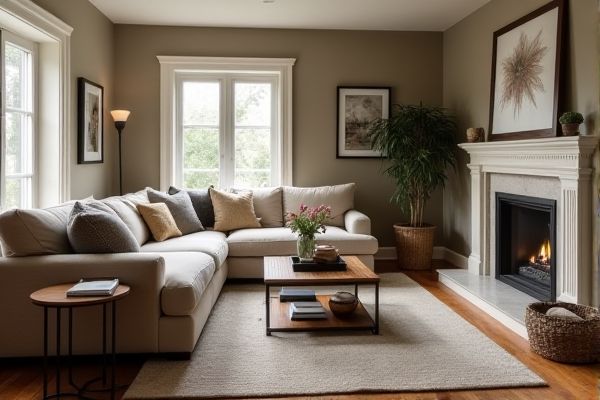
A basement sofa offers a compact and versatile seating option ideal for smaller spaces, while a sectional provides extensive seating and a customizable layout perfect for larger gatherings. Discover which choice best suits Your home's style and functionality by reading the rest of the article.
Table of Comparison
| Feature | Basement Sofa | Sectional Sofa |
|---|---|---|
| Design | Traditional standalone sofa | Modular, multiple connected seating units |
| Space Usage | Compact, fits small basements | Large footprint, ideal for spacious areas |
| Seating Capacity | Typically 2-3 seats | 4+ seats, customizable |
| Comfort | Basic cushioning, suitable for casual use | Enhanced cushioning, designed for extended lounging |
| Flexibility | Fixed shape and size | Reconfigurable sections for varied layouts |
| Price Range | Affordable to mid-range | Mid-range to premium |
| Best Use | Cozy, small entertainment areas | Large living rooms, family spaces |
Understanding Basement Furniture Needs
Basement sofas often prioritize durability and moisture resistance to withstand lower humidity and potential dampness, while sectionals offer versatile seating configurations to accommodate larger gatherings or family activities. Selecting the right basement furniture requires assessing space constraints, traffic flow, and intended use such as lounging, entertainment, or storage integration. Opt for materials like performance fabrics or treated leathers for basement sofas and modular designs in sectionals that maximize comfort and adaptability in varying basement layouts.
What Is a Basement Sofa?
A basement sofa is typically a compact, durable seating option designed to fit smaller or lower-ceilinged spaces often found in basements. Unlike a sectional, which offers multiple connected seating sections for larger gatherings, a basement sofa prioritizes space efficiency and comfort in confined areas. If your basement serves as a casual lounge or entertainment zone, choosing the right sofa can maximize both functionality and style.
What Defines a Sectional Sofa?
A sectional sofa is defined by its modular design, typically consisting of multiple connected seating pieces that form an L-shape or U-shape configuration, allowing for flexible arrangement in your living space. Unlike standalone basement sofas, sectionals maximize seating capacity by seamlessly combining chaise lounges, corner sofas, and armless seats into one cohesive unit. This adaptability and spacious seating make sectional sofas ideal for entertaining guests or accommodating family relaxation.
Space and Layout Considerations
Basement sofa and sectional options both offer unique space and layout benefits depending on your room size and shape. A basement sofa maximizes open floor space, making it ideal for smaller or irregularly shaped basements, while a sectional provides abundant seating and defines zones in larger, open-concept areas. Choosing Your furniture based on the basement's dimensions and traffic flow ensures optimal comfort and functionality.
Comfort and Functionality Comparison
Basement sofas often provide deep cushions and sturdy support, making them ideal for lounging and long relaxation sessions. Sectionals offer modular design and versatile seating arrangements, allowing you to customize the layout to fit your space and accommodate more people comfortably. Your choice between a basement sofa and a sectional should consider both the desired comfort level and the functionality needed for entertaining or everyday use.
Style and Aesthetic Versatility
Basement sofas often offer a cozy, straightforward design ideal for casual spaces, complementing rustic or industrial basement aesthetics. Sectionals provide enhanced style and aesthetic versatility with modular components that can be rearranged to fit different room layouts and design themes. Your choice depends on whether you prefer a simple, grounded look or a dynamic, customizable seating arrangement that adapts to evolving interior styles.
Durability and Maintenance Factors
Basement sofas often feature sturdy frames and moisture-resistant fabrics designed to withstand damp environments, enhancing durability and simplifying maintenance in below-grade spaces. Sectionals provide modular options with removable covers, allowing for easier cleaning and long-term upkeep, but may require more frequent care due to larger surface areas. Choosing the right option depends on your basement's humidity levels and how much effort you're willing to invest in preserving your furniture's appearance and structure.
Budget and Cost Analysis
Basement sofa options typically offer a more budget-friendly choice compared to sectionals, with prices ranging from $300 to $800 depending on materials and size. In contrast, sectionals often come at a higher cost, averaging between $1,000 and $3,000 due to their larger size and modular features. Your decision should weigh the initial investment against long-term comfort and space flexibility to align with your budget constraints.
Installation and Accessibility Challenges
Basement sofa installation often requires navigating narrow staircases and low ceilings, which can complicate delivery and setup. Sectionals, due to their modular design, usually offer easier accessibility, allowing you to assemble pieces individually in tight spaces. Choosing a sectional can minimize installation hassles and ensure your basement furniture fits seamlessly.
Choosing the Right Option for Your Basement
Selecting the ideal seating for your basement depends on space, functionality, and style preferences. A basement sofa offers a classic, streamlined look that fits smaller areas, while a sectional provides ample seating and versatility for larger or multifunctional basements. Your choice should balance comfort, layout, and how you plan to use the space to create a cohesive and inviting environment.
 homyna.com
homyna.com